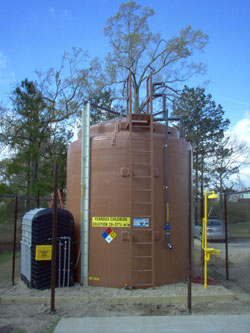Fentons Reagent and Hydrogen Peroxide

Fenton's Reagent is used to treat a variety of industrial wastes containing a range of toxic organic compounds (phenols, formaldehyde, BTEX, and complex wastes derived from dyestuffs, pesticides, wood preservatives, plastics additives, and rubber chemicals). The process may be applied to wastewaters, sludges, or contaminated soils, with the effects being:
- Organic pollutant destruction
- Toxicity reduction
- Biodegradability improvement
- BOD and COD removal
- Odor and color removal
Many metals have special oxygen transfer properties which improve the
utility of hydrogen peroxide (H2O2). By far, the most common of these is
iron which, when used in the prescribed manner, results in the
generation of highly reactive hydroxyl radicals (. OH). The reactivity
of this system was first observed in 1894 by its inventor H.J.H. Fenton,
but its utility was not recognized until the 1930s once the mechanisms
were identified.
Fenton's Reagent Case Studies
- A Louisiana chemical manufacturer used Fenton's process to pre-treat a 40 GPM wastewater stream, removing more than 90% of phenols.
- A refinery in the southeast US effectively pre-treated a 15 GPM scrubber blowdown stream prior to discharge to on-site biological treatment.
- A western US wood treating facility used Fenton's Reagent to remove phenols, napthols and cresols and eliminate inhibition of biomass and discharge violations.
- An aircraft paint stripping facility in the Midwest US pre-treated a wastewater stream to reduce targeted toxic organics by more than 95% prior to discharge.
- An Alabama chemical plant performed emergency treatment of phenol-contaminated wastewater, reducing levels from 200-300 mg/L to 0.2 mg/L overnight.
Fenton's Reagent Case Studies (PDF)
General Chemistry of Fenton's Reagent
General Chemistry of Fenton's Reagent
Back to top
Get More Information
Contact USP Technologies for more information on our products and services: